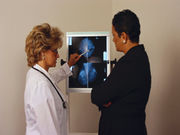Highest rates of false-positive results and additional imaging seen for women aged 40 to 49 years
TUESDAY, Jan. 12, 2016 (HealthDay News) — For women undergoing digital mammography screening, false-positive results are common, especially among younger women and those with risk factors, according to research published online Jan. 12 in the Annals of Internal Medicine.
Heidi D. Nelson, M.D., M.P.H., from the Oregon Health & Science University and Providence Health & Services in Portland, and colleagues conducted an analysis of registry data to examine factors associated with false-positive and false-negative digital mammography results. Data were included for 405,191 women aged 40 to 89 years screened with digital mammography between 2003 and 2011. Within 12 months of screening, 2,963 were diagnosed with invasive cancer or ductal carcinoma in situ.
The researchers found that the highest rates of false-positive results and recommendations for additional imaging were seen for women aged 40 to 49 years (121.2 and 124.9 per 1,000 women, respectively), and the rates decreased with increasing age. There was little variation in the rates of false-negative results (1.0 to 1.5 per 1,000 women) and recommendations for biopsy (15.6 to 17.5 per 1,000 women) by age. No difference was seen in results by time since the last screening. Women with risk factors had higher false-positive results, particularly family history of breast cancer, previous benign breast biopsy result, high breast density, and low body mass index for younger women.
“False-positive mammography results and additional imaging are common, particularly for younger women and those with risk factors, whereas biopsies occur less often,” the authors write. “Rates of false-negative results are low.”
Copyright © 2016 HealthDay. All rights reserved.








